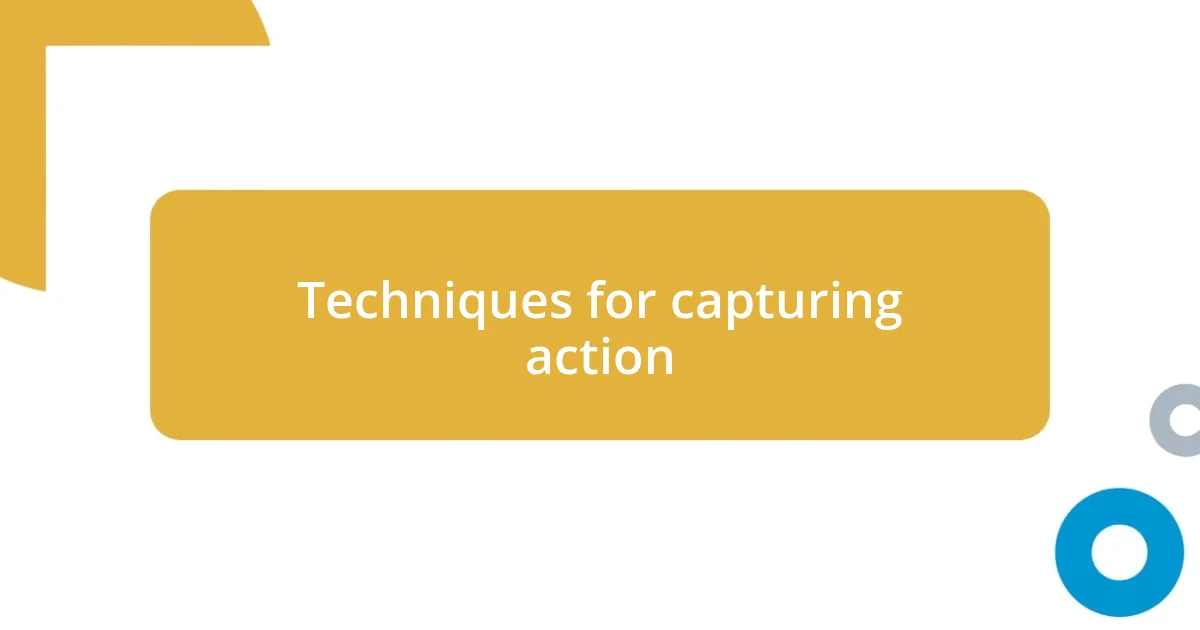Key takeaways:
- Sports photography requires not only the right equipment but also a deep understanding of the game and the stories behind the athletes.
- Key techniques like anticipation & positioning, panning, and continuous shooting significantly enhance the ability to capture dynamic action shots.
- Building an online presence, networking within the sports community, and creating tailored packages are essential strategies for successfully marketing photography services.

My introduction to sports photography
I still remember the first time I picked up my camera at a local football game. The energy in the air was electric, and I felt an irresistible pull to capture those fleeting moments. How could I resist the thrill of freezing time, seeing athletes pour their heart and soul into every play?
As I ventured deeper into sports photography, I quickly learned that it wasn’t just about pointing and shooting. It was about anticipating the action, feeling the rhythm of the game, and understanding the stories behind each athlete. I often found myself lost in the moment, sweating alongside players as they sprinted down the field—did I really just capture that winning goal?
Through countless events, I found my unique voice in this demanding field. The first time I delivered a striking image to a local magazine felt surreal. It sparked a fire inside me—who knew that my passion could resonate with others?

Choosing the right equipment
When it comes to sports event photography, the right equipment is crucial. I recall the first major tournament where I felt underprepared, realizing that my entry-level camera couldn’t keep up with the fast-paced action. Having the proper gear can significantly affect the quality of your images, allowing you to capture those intense moments that define the sport.
Here’s a simple list of essential equipment to consider:
- Camera Body: A DSLR or mirrorless camera that performs well in low light.
- Lenses: A fast telephoto lens (like 70-200mm) for close-up action shots and a wide-angle lens for environmental shots.
- Memory Cards: High-speed cards to avoid buffer delays during bursts of continuous shooting.
- Tripod or Monopod: Stabilization is key, especially for the longer lenses.
- Additional Batteries: You don’t want to miss that game-winning moment because your battery died.
Investing in quality equipment shifted my experience; I still remember the thrill of snapping a dynamic shot with my new lens during a recent match. It was like seeing the game through a whole new lens—literally! Each click now feels more assured, knowing my gear can keep pace with the excitement unfolding in front of me.

Techniques for capturing action
Capturing action in sports photography requires a keen eye and quick reflexes. I’ve found that the best moments often happen in an instant, so staying alert and anticipating plays is essential. During a high school basketball game, I instinctively positioned myself near the hoop, ready for a slam dunk. When it happened, the exhilaration shot through me as I pressed the shutter at just the right moment. That image still evokes the adrenaline I felt, a perfect example of how positioning and timing can create a powerful shot.
One technique I frequently utilize is panning, which involves tracking a moving subject while using a slower shutter speed. This method allows for a sense of motion while still keeping the main subject sharp. I remember practicing this technique at a local marathon; I set my shutter speed to 1/250 and followed the runners. The blurry backgrounds conveyed speed and intensity beautifully. There’s something thrilling about nailing that shot and feeling like I’ve captured the very essence of movement!
Lastly, continuous shooting mode is a game-changer. This setting allows you to take several shots in quick succession, perfect for those pivotal moments when everything aligns—a ball reaching the net, an athlete breaking the finish line, or an intense tackle on the field. I recall a soccer match where I captured a player’s fiery expression as he scored. My camera rattled off a series of images that turned out to be exceptional, each telling its own part of the story. This technique truly underscores the beauty of sports in freezing those peak emotions!
| Technique | Description |
|---|---|
| Anticipation & Positioning | Staying alert and finding the right spot increases chances of capturing action at crucial moments. |
| Panning | Tracking a moving subject with a slower shutter speed creates a dynamic shot with motion blur in the background. |
| Continuous Shooting Mode | Taking multiple shots in rapid succession to capture fleeting moments and pivotal expressions. |

Working with athletes and events
Working with athletes at events is both a privilege and a challenge. I remember my first opportunity to shoot a triathlon. The energy was palpable, with athletes buzzing in anticipation. As I navigated through the throngs to find the best angles, I realized that building rapport with the competitors enhanced my images. They’d flash a smile or offer a quick nod, and capturing that connection made my photos feel more personal and authentic.
Navigating the chaos of an event is an art form in itself. During a track meet, I found myself sprinting from one side of the track to the other to capture a runner’s powerful finish. It struck me then—how important it is to blend in and become a part of the atmosphere. By understanding the athletes and their routines, I could predict when the most thrilling moments would unfold. It’s like a dance, each moment a beat waiting to be captured.
I often wonder how I can tell each athlete’s story through my lens. A powerful moment for me came when I shot a young boxer about to step into the ring. You could see the nerves in his posture and the determination in his eyes. Framing that shot was easier when I understood his journey—how long he had trained, the sacrifices he made. It reminded me that behind every athlete is a story worth telling, and I strive to capture and convey that depth in my photography.

Editing and processing sports photos
Editing sports photos is where the magic truly happens for me. After a long day at an event, I often find myself excited to dive into editing. The first step typically involves selecting the standout images that resonate with the emotion of the moment. I remember sitting down after a thrilling football game, feeling the adrenaline still coursing through me as I narrowed down hundreds of shots to just a handful that captured pure joy, fierce competition, and raw emotion.
Once I have my favorites selected, I turn to tools like Lightroom or Photoshop for tweaking and enhancing. This process allows me to balance colors, adjust exposure, and sharpen details, bringing the images to life. I’ll never forget the time I enhanced a shot from a swim meet where the water droplets sparkled like diamonds. These subtle adjustments can make a significant difference, helping the viewer feel the energy and excitement just as I did that day.
What I truly appreciate about editing is how it allows me to tell a more profound story. When I’m working with a powerful action shot, I might consider cropping it in a way that highlights the athlete’s expressions, perhaps focusing on the determination etched on their face. I often ask myself, “How can I make this moment speak louder?” In that way, editing becomes an extension of my creative vision, transforming a great image into an unforgettable narrative.

Marketing your photography services
When it comes to marketing photography services, I’ve learned that building an online presence is essential. Social media platforms like Instagram have been my best friends, allowing me to showcase my work and connect directly with potential clients. I vividly recall posting a series of shots from a local marathon, and the response was incredible—people not only loved the images, but they also sought me out for their future events. It’s a beautiful cycle: the more I share, the more visibility my services get.
Another marketing strategy that’s worked wonders for me is networking within the sports community. I often attend local events just to meet athletes, coaches, and organizers. One memorable experience was chatting with a track coach who later referred me to their entire team for individual portraits. It’s amazing how a simple conversation can lead to opportunities. Don’t underestimate the power of word-of-mouth; it can be the most effective marketing tool in your arsenal.
Finally, creating packages tailored to specific events has made my offerings more appealing. For example, I once designed a package for a youth soccer league that included action shots, team photos, and individual portraits. I was surprised by the overwhelmingly positive response—it turned out that parents loved having these mementos of their children’s sports journey. Offering something unique not only helps in making sales but also builds lasting relationships with clients who appreciate your thoughtful approach.














